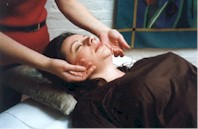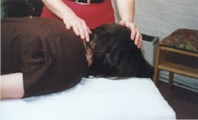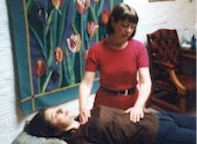Positive Health Online
Your Country

Kahi Loa - Traditional Hawai'ian Healing Massage
by Cornelia Biegler(more info)
listed in massage, originally published in issue 45 - October 1999
A healer and homeopath, I had began to wonder if somewhere there was a healing system in existence that involved a hands-on approach, and provided individuals with an empowering philosophy at the same time. In search of this system which was untypical of the many therapies available, my search took me as far afield as South East Asia, Australia and India, but remained inconclusive. Then, in early 1996 something unusual happened that would change my life: every day for some months, Hawai'i was being mentioned to me daily at least two or three times in one way or another. Something inside told me not to ignore this calling, so in May of that year I visited the beautiful island of Kaua'i and instantly felt as if I had come home.
In October of 1996 my travels took me there once again to attend a course in Hawai'ian Shamanism. At the time I also had to come to terms with the deaths of two people whom I had deeply loved. Emotionally tired, depressed and unable to sleep, one of the participants offered to give me a massage to help me relax, and I agreed.



Within a short space of time, and as if by sheer magic, the tension dissolved, and my body appeared to become lighter. Deeply relaxed, my thoughts began to slow down, my eyelids became heavy and I drifted in and out of, what can only be described as beautiful dreams. I was barely aware of those gentle hands encircling my whole being, which soaked up each massage stroke like a sponge.
Afterwards, I felt very calm and not only slept well for the first time in months, but also woke up the following morning feeling grounded, energised and at peace – a feeling that stayed with me for days to follow.
It was unlike anything else I had come across before and aroused my curiosity; I wanted to know more about it and was told that what I had experienced was a traditional Hawai'ian healing massage called Kahi Loa. On the final day of our gathering we were formally introduced to this ancient way of working and given the opportunity to practise on each other. As my hands raked, rolled, pinched and swept over my partner's body, I realised with amazement that my search had come to an end: Kahi Loa was what I had been looking for.
Two more trips followed to study the ancient esoteric Polynesian Huna philosophy, which forms the foundation of Kahi Loa.
Since then, I studied and researched the various aspects of this beautiful bodywork. Based on these findings and drawing on previous knowledge, I developed Kahi Loa further and modified the practical applications to fit in with what felt the most natural to my clients. This process of development has been ongoing and as time has passed, I discovered that it was like a treasure chest that, once opened, revealed the most beautiful jewel: a doorway leading to a path of growth and continually increasing awareness and understanding of Life and Life Force.
What is Kahi Loa?
Kahi Loa is a traditional form of healing or massage that originated in Hawai'i, where for centuries, it was widely practised by the islands' Master Healers. Blending the metaphysical with the scientific approach, Kahi Loa is much more than just a massage technique – incorporating the belief that using the Mind and Nature harmonises and heals makes it a totally unique approach to well being.
Translated, the words mean something like "Oneness through (the moving or flowing of) Sacred Energy", and refers to a state of Unity with Life in its entirety, but the word Kahi also refers to light pressure in massage and to touch.
Kahi Loa concentrates on the skin, the body's largest and oldest organ, and is carried out with the recipient wearing light, natural clothing. As the skin is an organ of elimination, the clothing allows for absorption of any toxins that may exude from it during the session. The remainder is released back into the blood stream for later excretion, a process that is best supported through drinking plenty of fluids. The skin often holds much tension, which is relieved through light pressured finger or hand movements and on or above the body touching and stroking. Triggering the production and release of endorphins, the body's own analgesic and "feel-good" chemicals, a state of inner calm and deep relaxation is achieved quickly. The recipient's own healing abilities are stimulated through free flowing energy and often a gurgling can be heard in the stomach when some kind of release has taken place.
The head to toe massage is divided into seven segments, which are first carried out on the back and then on the front of the body, with arms and hands always being worked on last. Each of these segments corresponds with one of the elements related to Hawai'ian healing and mental focus is on the recipients' desired state of physical or emotional health, which is affirmed prior to treatment. During the practical applications, a journey through Nature is silently visualised for the client and complemented by further non-verbal affirmative statements, using the symbolic meaning of the elements. The treatment is completed with a prayer, asking for all energy to flow freely into the blessing and manifestation of the client's required changes and followed by an appropriate period of rest.
Ancient Philosophy – Modern Day Truth
To the ancient Hawai'ians everything was alive and had energy. For without energy, they concluded, nothing could be in existence. They enjoyed a particularly close relationship with Nature and perceived All of Life as One, made up of seven vital components or elements, originating from the same source.
Fire and The Sun, Water, Air and Wind, Earth and Stone, Plants, Animals as well as Human Beings or Loving Touch were considered life giving and healing. The Master Healers had a deep understanding of the workings or laws of Nature and attributed specific functions and symbolic meanings to each of the elements. Without them, they were convinced the existence and survival of all living things would be threatened if not impossible.
Since all Life derived from the same source and since everything had energy, they called on the elemental forces and their energies for support. Through ceremonial prayers, blessing and chanting, often preceded by breathing rituals, they daily invoked Nature or Life's gifts. This ensured that their own life force, which they called "The Water of Life" kept flowing freely without the flow becoming blocked or seeping away.
To further strengthen their life force and prevent it from weakening, the Hawai'ians utilised the healing energies of everything that Nature in her generosity provided. They had knowledge and made use of the healing qualities of plants, herbs, flowers and fruit, but even stones and shells were employed when appropriate.
They also attributed a higher and more refined energy to Touch and were aware of its healing powers. Therefore it was frequently used through the Laying on of Hands or by means of Massage, which was also firmly established as part of family life. Children were massaged throughout infancy, often into adolescence. Massage or even a slight touch was taken seriously and was considered much more than just an expression of affection or play. It was considered a sacred healing ceremony, requiring not only total concentration and dedication, but also unconditional love or acceptance and forgiveness
Healing was viewed as an ongoing process, known to be accelerated and enhanced through living by certain concepts and associated behaviour. The only real sin the Hawai'ians knew was that of intentionally harming another living being (including themselves) and in accordance with their belief that everything has energy, this too applied to thoughts which were said to hold energy. Limiting beliefs as to what a person could achieve were not only disempowering, but weakened the life force and might bring to life the very condition or state they did not want! Having observed the effects of negative thoughts on the body, healers, physicians or massage practitioners were free of preconceived ideas as to what kind of changes or healing a patient was able to create in his or her life. Imagination was seen as an indis- pensable tool and both would focus their attention on the desired changes and imagined that they had already taken place! Thus conscious and clear instructions were issued to what they termed the sub-conscious, as this was said to hold the memory to heal.
As mentioned earlier, touch was a recognised and accepted form of healing that is probably as old as mankind. Used by shamans, medicine men and healers all over the world, it was also incorporated into religion and life styles. Touch is also a form of contact, an unspoken, almost forgotten language and most probably the oldest form of communication known. Therefore, the intent with which we touch another human being is of prime importance.
But, what does happen when we touch?
The Skin and Touch as a Basic Human Need
Symbolically the skin is said to resemble individuality and the ancient Egyptians used a hieroglyph, showing three skins tied together, denoting body, soul and spirit.[4] It is the largest and oldest organ of the body, providing the body with a protective covering, but is also found in the eyes, mouth, nostrils, and the digestive system. It makes up anything from 12 – 20%[2] of our body weight and can cover an area of 18 square foot. Deriving from the same cell tissue as the brain and Central Nervous System, Ashley Montagu[1] referred to it as the External Nervous System. The skin has a multitude of important functions and is, of course, the home of the Sense of Touch and Feeling – the earliest to develop in humans and animals, including birds.[1] Holding approximately five million sensory receptors, it is an organ of great awareness, keeping us in constant contact with our surroundings and communicating sensations or messages to the Central Nervous System, which are then consequently sent to the organism. The skin also accurately reflects our emotional state and many skin conditions are thought to be of emotional origin.
Tactile areas cover a large area in the sensory and motor region of the brain,[2] especially those being representative for lips, tongue, face and hands.[2] Touch is considered "a fundamental, primitive need for the healthy ego development of all human beings".[5] Recent research has shown that stimulation to the skin by means of tender touch is essential for the development of basic human qualities, such as emotional security, confidence, safety and acceptance. Deprivation of tactile stimulation can cause emotional damage in children and lead to behavioural problems, such as extreme shyness, fear or aggression and the inability to show affection.[1,2,3]
Touching and stroking is therapeutic and vital to our physiological and emotional well being. It promotes the flow of energy and stimulates and regulates the function of our inner organs,[2] thus allowing the body's own healing process to commence.
To-date, various studies into the effects of massage, touching and stroking have been carried out in the UK and the United States to assess their benefits. At Miami Medical School it was discovered that prematurely born babies in incubators gained weight quicker and were more alert than those treated conventionally.[3] The University of Colorado's studies into wound healing revealed that touch accelerated the healing process when the hands were placed near the wound. Healing Touch has since been introduced into all their hospitals. The 19th Century wasting disease "Marasmus" claimed the lives of many orphans before their first birthday and a study undertaken many years later established the link between lack of tactile contact and these babies' deaths. Touch-massage applied to the elderly with abnormal behaviour resulted in their being much more relaxed and decreased abnormal behaviour. It also encouraged them to communicate differently with their nurses.[5] Touch has been associated with lower stress hormone levels, pain alleviation and changes in the heart rate;[5] in comatose patients a cardio-vascular reaction has been noted as a direct result of gentle physical contact.[1] Gentle massage has also proved beneficial to asthmatic children, who became less anxious and adopted a more positive attitude toward their Asthma.[5] Counsellors who incorporated touch into their sessions found that clients responded more positively to therapy[5]. In contrast, tactile stimulation applied by a battery-operated brush did not produce significant effects.[5]
The act of touching is carried out involving the use of our arms and hands. Seen as a physical manifestation of our inner state, they act as a channel for expressing emotions and attitudes. To the Berbers, the hands resembled protection, authority, power and strength and to the Egyptians the open hands signified magnetic force.[4] Symbolically, and most importantly, the fact that each hand has five fingers is given importance as the number Five indicates Love, Health and Humanity.[5]
Over the last few years, the demand for massage and other therapies involving touch in one form or another has increased dramatically. This is not surprising, considering that many of us are deprived of something that is really a natural basic requirement and a requisite to our overall health because deep inside each human being is the need to be loved and accepted. By way of touching we experience virtual reality and connect with our own source of power.[6] We honour that within which is good and pure and words unspoken transmit our acceptance of the fact that we are all part of Nature.
The Hawai'ian belief that Life is made up of seven components is certainly valid. Nature provides us not only with nourishing food and water for the body; she has also provided us with fellow human beings for emotional closeness, which is expressed through tender touch. As hand in hand we walk this Earth, watching the sun rise and set, listening to the song of a bird or the falling rain and rustling of leaves in the wind, smelling the sweet scent of a beautiful flower, that is when we are truly At One with Life.
In practice I, as well as my students, have observed physical and emotional or attitudinal changes after treatment, especially after several consecutive treatments revolving around the same issue and using the same focus or desired healing. Recognising what needs to be healed (many of us know) and verbalising this intent in the present tense is in itself an opening door to whatever approach or philosophy is appropriate for each individual.
After treatments and workshops, clients and participants comment that muscular tension has been relieved and that they feel "alive". They look rejuvenated and feel calm, clear and grounded. There is usually an increase in energy – unless a person is already in a totally exhausted state, which may be temporarily highlighted, but is followed by deep and refreshing sleep.
Case Studies
One client (F, 33) used to wake at 3.00 a.m. every morning, a symptom that disappeared after one session. The same client also commented that she had never been particularly tidy, and that she returned home to totally "blitz" (as she put it) her flat. She felt emotionally much stronger, and found she was coping much better with her high-pressured job and family problems.
Another client (M, 47), who had already benefited from Psychotherapy, was uncertain about his future career and had felt physically weak. He called to tell me that he was feeling much better and clearer about where he is going.
Mrs. M. (76) had dislocated her left shoulder twice within six weeks and was receiving physiotherapy. At the time of her visit she was still in much pain and unable to fully raise her arm. She telephoned later that evening and reported that she was able to raise it to shoulder height and that she was in less pain.
Ms. C. (27) felt drained, depressed and unmotivated after her appendectomy. After the first treatment she noticed an increase in physical and mental energy and that she no longer needed to talk herself into performing tasks. She also reported that she felt more joy.
Ms.R. (45) experienced her first Kahi Loa when she was suffering with a severe migraine. After the treatment she reported that the headache had totally gone. This is what she wrote to me two weeks later: "Kahi Loa is my idea of bliss, it is the ultimate treatment for those of us who are feeling extremely stressed. The effect on body and mind is astonishing – you literally slip into the deepest levels of relaxation, which is sheer paradise!"
References
1. Montagu, Ashley. Touching and the Human Significance of the Skin, Harper & Row New York, ISBN 0-06-096028-0
2. Davis, Phyllis K. The Power of Touch, Hay House Inc., California, ISBN 0-937611-91-3
3. Caplan, Mariane. Untouched – The Need for Genuine Affection in an Impersonal World, Hohm Press Arizona, ISBN 0-934252-80-7 (not available in the UK)
4. Cirlot, J. E. A Dictionary of Symbols Routledge London, ISBN 0-415-03649-6
5. Research Council for Complementary Medicine – Massage and Touch Research Pack
6. Lauterstein, David. The Seven Dimensions of Touch, Kindred Spirit, issues 41 & 42.
Further Reading
* Tom Harpur: Uncommon Touch – An investigation into Spiritual Healing.
* Serge Kahili King: Mastering your Hidden Self/urban Shaman/Imagineering for Health.
* Allen & Lisa Lawrence: Huna – Ancient Miracle Healing Practices and the Future of Medicine.
* Ronald Shone: Creative Visualisation.
* Rosalie Samet: Hawaiian Huna Massage (Kahuna Bodywork): The Wisdom of Paradise in Motion. Positive Health, Issue 20.
Comments:
-
No Article Comments available